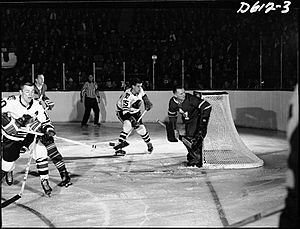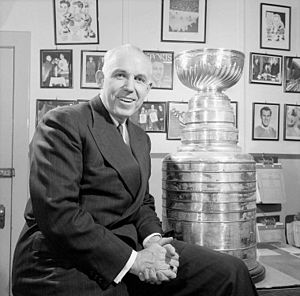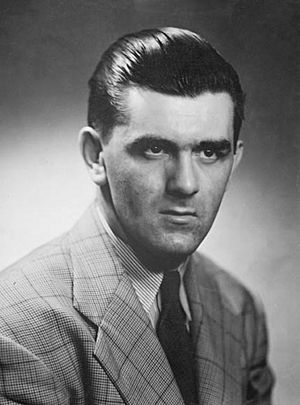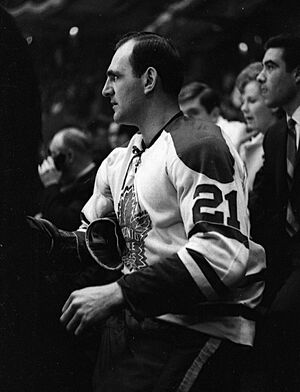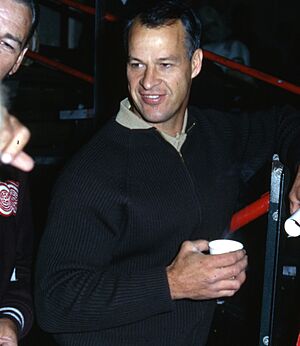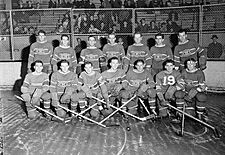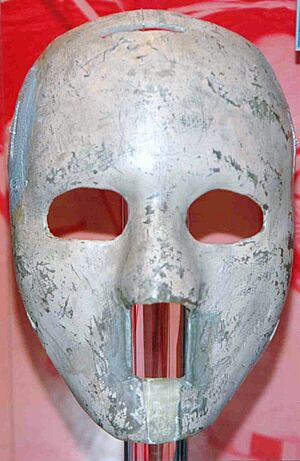History of the National Hockey League (1942–1967) facts for kids
The "Original Six" era of the National Hockey League (NHL) started in 1942. At this time, the league had only six teams: the Boston Bruins, Chicago Black Hawks, Detroit Red Wings, Montreal Canadiens, New York Rangers, and Toronto Maple Leafs. This setup lasted for 25 years. The era ended in 1967 when the NHL added six new expansion teams, doubling its size.
The Stanley Cup became the official championship trophy in 1947. Before that, it was already the main championship, but the NHL gained full control of it in 1947. During this time, the Toronto Maple Leafs and Montreal Canadiens were very strong teams. The Maple Leafs won the Stanley Cup nine times, including three years in a row from 1962 to 1964. They also won the last Original Six Stanley Cup in 1967. The Canadiens won ten times, including an amazing five straight titles from 1956 to 1960.
Many famous players made history during this era. Maurice Richard was the first player to score 50 goals in a single season in 1944. In 1955, Richard was suspended after a clash with an official, which led to the Richard Riot in Montreal. Gordie Howe started his career in 1946 and played for 32 years, becoming the NHL's all-time leader in goals and points when he retired. Willie O'Ree broke the NHL's colour barrier in 1958 when he played for the Bruins, becoming the first black player in the league.
The NHL also brought in new rules and ideas. In 1943, the league added the centre-ice red line to make the game more open. This allowed players to pass the puck out of their defensive zone for the first time. In 1959, Jacques Plante became the first goalie to regularly wear a face mask for protection. Off the ice, the business side of hockey changed too. The first amateur draft was held in 1963 to help spread talent more evenly among teams. The National Hockey League Players Association (NHLPA) was formed in 1967, giving players a stronger voice.
Contents
How the League Changed
In the 1930s and early 1940s, tough times like the Great Depression and World War II hurt the NHL. The league once had ten teams, but money problems caused many to close down. By the 1942–43 season, only six teams were left. These six teams are now known as the "Original Six." The league stayed this way until 1967.
The league also got a new leader. In 1943, NHL President Frank Calder passed away. Red Dutton took over, but he resigned in 1946. Then, Clarence Campbell became the NHL president. Campbell stayed in charge until 1977. His time as president saw the league become very stable. For the first 21 years of his leadership, the same six teams played for the Stanley Cup. This time is often called the "golden age of hockey." Rivalries between teams grew stronger, and new rules made the game more exciting.
Hockey During and After World War II
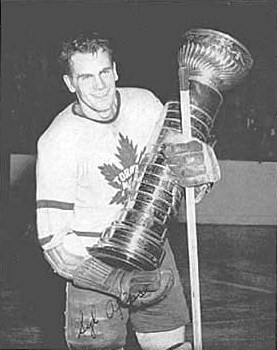
World War II made it hard for teams to find players because many went to fight. By the 1943–44 season, teams were struggling to fill their rosters. For example, the Rangers had only five players returning from the previous season. Their general manager, Lester Patrick, even thought about stopping the team from playing until the war ended. But they kept playing, and the Rangers won only six games that year. Their 42-year-old coach, Frank Boucher, even played in 15 games to help out!
The 1943–44 Canadiens were incredibly strong, losing only five games all season. They didn't lose any games at home! They won the Stanley Cup that year, their first in 14 seasons. The next season, the Canadiens were strong again, but the Toronto Maple Leafs surprised them in the playoffs and won the Cup.
After 1926, NHL teams were the only ones playing for the Stanley Cup. In 1947, the NHL made a deal with the Cup's trustees to control the trophy. This meant the league could decide who could challenge for the Cup. The Hockey Hall of Fame was also started in 1943 in Kingston, Ontario. Its goal was to honor great hockey players. The first eleven members were added in 1945. The Hall of Fame found a permanent home in Toronto in 1961.
On October 13, 1947, the first official All-Star Game was held in Toronto. The NHL All-Stars played against the Toronto Maple Leafs to raise money for the NHL Pension Society. The game raised C$25,000 and became a yearly tradition.
"Rocket" Richard's Impact
The Canadiens of the 1940s had a famous line of players called the "Punch line": Elmer Lach, Toe Blake, and Maurice "Rocket" Richard. In the 1944–45 season, these three players were the top scorers in the NHL. Richard became very famous for trying to score 50 goals in a 50-game season, something no one had done before. On December 28, 1944, he set a record by scoring five goals and three assists in one game. Teams tried hard to stop him from reaching 50 goals, but in the last game of the season, Richard scored his 50th goal in Boston. No other player scored 50 goals in 50 games until Mike Bossy in 1980–81.
In March 1955, Richard was suspended for the rest of the season after a fight during a game. This made many fans, especially French-Canadians, very angry at NHL President Campbell. They felt he was unfair to Richard. Campbell still went to a game in Montreal on March 17. His presence caused a huge crowd to gather outside the arena. A tear-gas bomb was thrown inside, and the building had to be cleared. A large riot happened outside, with many people arrested and stores damaged. This event became known as the Richard Riot.
The next day, Richard asked fans on the radio to stop the rioting and support the Canadiens in the playoffs. He said he would accept his punishment and come back to win the Cup next year. The Canadiens lost in the 1955 Stanley Cup Finals, but Richard led them to win the Stanley Cup in 1956. This event showed the growing differences between French Quebec and English Canada.
On October 19, 1957, Richard became the first player to score 500 career goals. He retired in 1960, having won eight Stanley Cups and becoming the NHL's all-time leading scorer with 544 goals. In 1961, he was quickly added to the Hockey Hall of Fame.
Hockey Night in Canada on TV
In 1951, Conn Smythe, who owned the Maple Leafs, looked into broadcasting hockey games on television. Some in the NHL, like President Campbell, worried that TV would stop people from coming to games. But in 1952, even though only 10% of Canadians had a TV, the Canadian Broadcasting Corporation (CBC) started showing games.
On November 1, 1952, Hockey Night in Canada was first shown on TV. Foster Hewitt called the game between the Leafs and Bruins. These broadcasts quickly became the most popular show on Canadian television. A French-language broadcast, La Soirée du hockey, also started around the same time.
Smythe believed that TV would actually make more people want to see games live. He thought that seeing professional hockey on TV would make new fans want to go to the rinks. In 1956, CBS started broadcasting hockey games in the United States as an experiment. It was so popular that they started showing 21 games the next year.
The NHL also made changes to make the game better for TV viewers. In 1949, the league made teams paint the ice white so the puck was easier to see. In 1951, teams were told to wear colored jerseys at home and white jerseys on the road so they could be told apart on black and white TVs.
Amazing Teams and Dynasties
Toronto Maple Leafs' Wins
In the 1951 Stanley Cup Finals, the Maple Leafs beat the Canadiens four games to one. All games in this series were decided in overtime, which is the only time that has happened in NHL history! Leafs' defenseman Bill Barilko scored the winning goal. This was Toronto's fourth Stanley Cup in five seasons. Four months later, Barilko disappeared during a fishing trip. His plane was not found until 1962, the same year the Maple Leafs won the Cup again. Many fans thought the team was under a curse until Barilko's remains were found.
The Leafs won the championship in 1962 and again in 1963. In 1964, they played the Red Wings for the Stanley Cup. In game six, Leafs' defenseman Bobby Baun broke his ankle from a Gordie Howe shot. Even with the injury, Baun returned to the game with his ankle taped up and scored the winning goal in overtime! Baun also played in game seven, and the Maple Leafs won their third straight title.
Detroit Red Wings' Success
Starting in 1948–49, the Red Wings won seven regular season titles in a row, a record no other team has matched. During this time, the Wings won four Stanley Cups. In the 1952 Stanley Cup Finals, a fun tradition called the Legend of the Octopus began. Two brothers brought a dead octopus to a game, believing its eight tentacles represented the eight wins needed to win the Stanley Cup. The Wings won that game, and the tradition continues today.
The Wings were led by Gordie Howe. He was invited to the Red Wings' camp when he was 15, and the coach called him "the best prospect I've seen in 20 years." Howe started playing in the NHL for Detroit at age 18 and played until he was 52!
Montreal Canadiens' Dominance
Between 1954 and 1956, the Red Wings and Canadiens played each other in three straight Stanley Cup Finals. Detroit won the first two, but Montreal won the 1956 Stanley Cup. This win started a new period of dominance for the Canadiens. They went on to win five championships in a row from 1956 to 1960, a feat no other team has ever done!
In 1953, the Canadiens signed Jean Beliveau, a highly anticipated player. He was so good that Montreal bought his entire league just to get him to sign with them! Beliveau signed a huge contract for a rookie and went on to win ten Stanley Cups with Montreal.
The Canadiens of the 1950s, led by Richard and Beliveau, had an amazing offense. To make the game more fair, the NHL changed some rules. For example, in the 1955–56 season, Beliveau once scored three goals in just 44 seconds during a power play! The next season, the league made a new rule: if a team scored a goal during a power play, the penalized player could return to the ice early.
Breaking Barriers: Willie O'Ree
On January 18, 1958, Willie O'Ree made history by becoming the first black player in the NHL. He joined the Boston Bruins for a game in Montreal. O'Ree played only two games in the 1957–58 season and then 43 more games in 1960–61. Even though he played only 45 NHL games, he is known as the "Jackie Robinson of hockey" for breaking the color barrier.
During his time in the NHL, O'Ree faced mean comments from fans in some cities. But his teammates and Boston fans supported him. He said his teammates like Johnny Bucyk and Doug Mohns "accepted me totally." In 1961, O'Ree was traded to Montreal but didn't play for the Canadiens. He played over 20 seasons in minor leagues and twice won the scoring title in the Western Hockey League.
O'Ree's breakthrough came years after another black player, Herb Carnegie, was denied the chance. In 1938–39, Carnegie was told by his coach that the Maple Leafs owner, Conn Smythe, would sign him "if he could turn you white." Carnegie was hurt by this but worked even harder. In 1950, the Rangers offered him a spot on their lowest minor league team. Carnegie turned it down, saying his family "couldn't eat headlines," meaning the offer wasn't good enough.
The "Norris House League"
In the 1960s, some people joked that "NHL" stood for "Norris House League." This was because the Norris family owned parts of several league teams. James D. Norris owned the Black Hawks with Arthur Wirtz. His brother Bruce owned the Red Wings. James D. Norris also had a lot of control over the Rangers.
The Black Hawks were not very good for many years, making the playoffs only once between 1949 and 1957. Their luck changed in 1958–59 when they got Ted Lindsay and Glenn Hall from Detroit. The Black Hawks reached the playoffs and won their first championship in 23 years in the 1961 Stanley Cup Finals. They wouldn't win the Cup again until the 2009-10 season.
As the Hawks got better, Norris and Wirtz sometimes took advantage of their fans. Fans called them the "Chicken Wings" because of how they treated customers. Ticket sellers were caught charging too much for tickets. The team also refused to show away playoff games on TV in Chicago, instead making fans pay to watch them on a special closed-circuit TV at the arena. Fans showed their unhappiness by throwing things on the ice and asking others to boycott the team.
League Expansion
In 1963, Rangers owner William Jennings suggested adding two new teams to the league on the American West Coast. He worried that another league, the Western Hockey League, might become a major league. Jennings also hoped that having teams on the West Coast would make the NHL a truly national league and help it get back on TV in the United States. The owners didn't agree at first, but they kept talking about expansion.
In 1965, they finally agreed to add six new teams, doubling the size of the NHL! Cities like San Francisco–Oakland, Vancouver, Los Angeles, and St. Louis were considered. Fourteen cities from Canada and the United States applied.
In February 1966, the league chose Los Angeles, Minnesota, Philadelphia, Pittsburgh, San Francisco, and St. Louis. Each team paid $2 million to join. St. Louis was given a team even though no one had officially bid for it. This was partly because the Norris and Wirtz families owned the arena in St. Louis.
Canadians were very upset that no new teams were given to Canada. Even Prime Minister Lester B. Pearson said the decision went against "sacred principles of all Canadians." Maple Leafs coach Punch Imlach said that Toronto and Montreal didn't want to share TV money with another Canadian team.
The Original Six era ended with the 1967 Stanley Cup Finals between the Montreal Canadiens and the Toronto Maple Leafs. The Maple Leafs, known as the "over the hill gang" because of their older players like 37-year-old goalie Terry Sawchuk and 42-year-old Johnny Bower, won the Cup in six games. They became the oldest team to win the Cup, beating the favored Canadiens. The Maple Leafs have not been back to the Stanley Cup finals since.
New Rules and Ideas
In 1942, during World War II, the NHL stopped having overtime in regular season games because of travel rules. Teams needed to catch their trains on time. Overtime didn't return for regular season games until the 1983–84 season. Playoff games, however, always continued until a winner was decided.
In 1943, the league wanted to make the game faster. Rangers coach Frank Boucher suggested adding a centre red line to divide the neutral zone. This allowed teams to pass the puck out of their defensive zone into the middle of the ice. Before this, players had to carry the puck out of their defensive zone. The new rule, started in 1943–44, changed the game a lot. Scoring went up by 10% across the league.
In the early 1960s, Stan Mikita accidentally started using a curved blade on his hockey stick. He cracked his blade during practice and noticed the curve made the puck act differently. Both Mikita and Bobby Hull started bending their stick blades on purpose. Mikita won four scoring titles using a curved blade, but he later said he regretted the idea because it made backhand shots harder.
The NHL Amateur Draft was first held on June 5, 1963. President Campbell created it to help spread talent more evenly among teams. Before this, teams would directly sponsor junior hockey clubs and buy the rights to young players. Garry Monahan, a 16-year-old, was the first player ever picked in the 1963 draft. He is still the youngest player ever drafted in the NHL. The draft system didn't fully replace the old sponsorship system until 1969.
Goaltending Innovations
Goalie Clint Benedict was the first to wear face protection in 1930 to protect a broken nose. But he stopped using it because it blocked his vision. Twenty-nine years later, Jacques Plante made the goalie mask a regular part of hockey. Plante started wearing a mask in practice in 1956 after shots broke his cheekbones twice. His coach, Toe Blake, didn't want him to wear it in games.
But on November 1, 1959, Plante was hit in the face during a game. There were no backup goalies, so the game was stopped for 20 minutes while doctors stitched him up. Plante refused to return unless he could wear his mask. Blake finally agreed, but only if Plante took it off when his face healed. With the mask, Plante led the Canadiens on an 18-game unbeaten streak. When he took the mask off, the team lost their first game. Blake then let Plante wear the mask permanently, and the Canadiens won their fifth straight Stanley Cup. Soon, other goalies started wearing masks too.
Amazingly, Terry Sawchuk played most of his career without a mask. He used a low "gorilla crouch" stance. Sawchuk was known for his amazing ability to see the puck, his quick movements, and his reflexes. He won four Vezina Trophies and was considered one of the greatest goalies. Sawchuk's style of play was an early version of the modern "butterfly style."
The "butterfly style," used by most goalies today, was invented by Glenn Hall. Hall would drop to his knees and kick his pads out in a V shape, forcing shooters to aim for the top of the net. Hall started using this technique when he was young because he wasn't strong enough to stop shots with his stick. Hall played 502 consecutive games as a goalie for Detroit and Chicago, a record that is very hard to break.
Players Form a Union
The first players' union was started on February 12, 1957, by Red Wings player Ted Lindsay. Lindsay and other players were unhappy because the league wouldn't let them see the financial records for the players' pension fund. The league said it wasn't making much money, so it couldn't contribute more. But players on the pension committee thought otherwise. Lindsay and Doug Harvey of the Canadiens started talking about forming a union in 1956. The idea quickly became popular, and almost every NHL player joined.
The team owners immediately tried to stop the union. Toronto owner Conn Smythe compared the players' association to communism. Red Wings president Bruce Norris traded Lindsay to his brother's team, the Black Hawks. This move was seen as a punishment because the Hawks were usually the last-place team. Other players who supported the union were also traded or benched. The Players' Association then filed a lawsuit against the NHL. But after some Red Wings players voted to leave the association, other teams followed. The union eventually agreed to drop the lawsuit in exchange for small improvements, like a minimum salary of $7,000 per year and better pension contributions.
The National Hockey League Players' Association (NHLPA) was officially formed in 1967, led by Alan Eagleson. Eagleson became the first player agent in 1966 when he helped Bobby Orr get a deal that made the 18-year-old rookie the highest-paid player in the NHL. The NHLPA was announced in June 1967 and was quickly accepted by the team owners.
Timeline

Notes
- "SC" means the team won the Stanley Cup
See also


